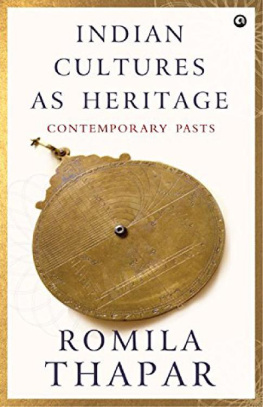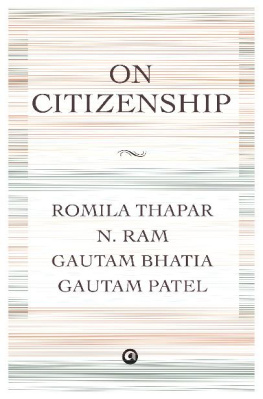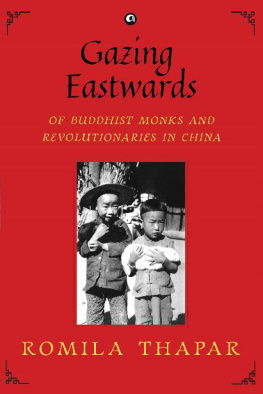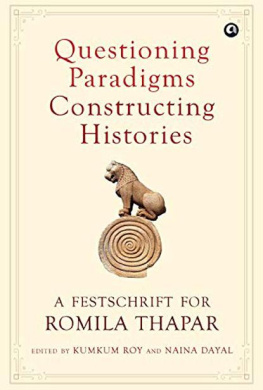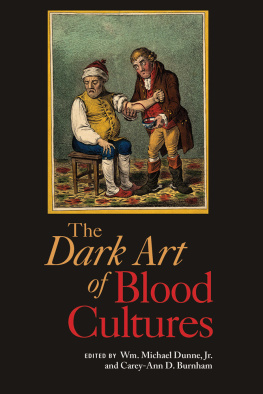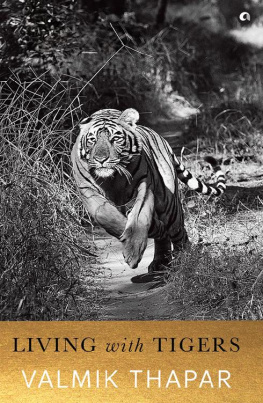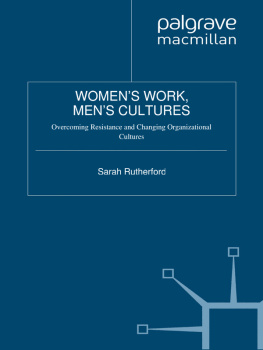INDIAN CULTURES AS HERITAGE
Also by Romila Thapar in Aleph
On Nationalism
The Public Intellectual in India
The Past As Present: Forging Contemporary Identities Through History


ALEPH BOOK COMPANY
An independent publishing firm
promoted by Rupa Publications India
First published in India in 2018
by Aleph Book Company
7/16 Ansari Road, Daryaganj
New Delhi 110002
Copyright Romila Thapar 2018
All rights reserved.
The author has asserted her moral rights.
The views and opinions expressed in this book are the authors own and the facts are as reported by her, which have been verified to the extent possible, and the publishers are not in any way liable for the same.
No part of this publication may be reproduced, transmitted, or stored in a retrieval system, in any form or by any means, without permission in writing from Aleph Book Company.
ISBN: 978-93-84067-35-9
1 3 5 7 9 10 8 6 4 2
This book is sold subject to the condition that it shall not, by way of trade or otherwise, be lent, resold, hired out, or otherwise circulated without the publishers prior consent in any form of binding or cover other than that in which it is published.
CONTENTS
PREFACE
The questions that I asked when I was putting together this book were many and they revolved around the broader issues of heritage and culture. Some were questions that are generally not asked when heritage and culture are under discussion. Three centuries ago the definition of both was clear and uncomplicated. But now there are a range of definitions that recognize the many cultures that make up a society and the multiplicity of its heritage. My attempt here is to consider just a few among the many, merely to suggest that there is much that we miss out when we speak of culture as it was defined in earlier times.
Both culture and heritage require a context that refers them to their past or the present, so that they can be recognized as representing what we perceive as patterns of living, patterns that we are now beginning to concede give a direction to cultures. Their links may not be visible to historians. Or, possibly, my concern was with searching for the context of cultureseven if I was considering just a fewand in no particular order. This too underlines the connectedness. My focus, therefore, is on contexts rather than on objects. As it had been said, objects have an aura. I would argue that seeing each in its context heightens that aura. But this may again be just the obsession of an historian.
My other argument in this book is that we have in the past often thought of culture as single, as representing everyone in that singularity. For this singularity we have generally selected, or at least given it pride of place, the pattern of living and thinking of the elite. High culture was what made for civilization, and the rest did not matter too much. But now we know that in searching for the contexts of cultures, much comes from a hierarchy of sources, from high all the way down, and has to be acknowledged. My concern in this book is with a few of the many varied contexts that give an identity to cultures. My argument is not that every item of what we call culture has to be taken through a span of contexts, but that it might be worth investigating whether there are contexts other than the obvious ones.
In writing this book, I have drawn partly on some lectures that I have given in recent years to diverse audiences, and partly on published essays. These I have revised and rewritten in the last few months. My intention was to select a few themes and consider how they may be viewed as having contributed to the articulation of Indian cultures.
I would like to thank David Davidar and Aienla Ozukum at Aleph for their helpful comments and reactions to the text.
Romila Thapar
New Delhi
December 2017
INTRODUCTION: DEFINING CULTURES
W e use the word culture quite casually when referring to a variety of thoughts and actions. I would like to begin my attempt to define cultures by a focus on three of its dictionary meanings that I think are significant to our understanding of the general termculture. We often forget that its more essential usage is as a verb rather than as a noun, since the noun follows from the activities involved in the verb. Thus the verb, to culture, means to cultivate. This can include at least three activities: to artificially grow microscopic organisms; to improve and refine the customs, manners and activities of ones life; to give attention to the mind as part of what goes into the making of what we call civilization, or what was thought to be the highest culture. In short, one might argue that culture is the intervention of human effort in refining and redefining that which is natural, but that it gradually takes on other dimensions in the life of the individual, and even more in the interface between the individual and society.
When speaking of society, this word also requires defining. Society, it has been said, is what emerges from a network of interactions between people that follow certain agreed upon and perceptible patterns. These are determined by ideas of status, hierarchy and a sense of community governing the network. They are often, but not invariably, given a direction by those who control the essentials in how a society functions, as for instance, its economic resources, its technology and its value systems. The explanation and justification for who controls these aspects of a society introduces the question of its ideology and often its form. The resulting patterns that can be differentiated from segment to segment of the society are frequently called its cultures.
Most early societies register inequalities. The access of their members to wealth and status varies. The idea of equality therefore has many dimensions. All men and women may be said to be equal in the eyes of God but may at the same time be extremely differentiated in terms of income and social standing, and therefore differentiated in the eyes of men and women. There may be small social segments such as jatis (castes) that may each have a hint of equalityalthough even among them there is a hierarchy. This would not apply to the entire society. There may be times when societies conform to a greater degree of equality, but such times may be temporary. It has been argued that on a pilgrimage, the status of every pilgrim is relatively similar but at the end returns to inequalities. Societies are not static and change their forms and their rules of functioning. Cultures are reflections of these social patterns, so they also change.
My attempt in this introduction is to explain how the meaning of a concept such as culture has changed in recent times and has come to include many more facets than it did earlier. This perhaps is pertinent to my choice of subjects included in this book. What we understand as the markers of culture have gone way beyond what we took them to be a century or two ago. The items of heritage that I have included in the first few chapters are an example of this change.
Apart from items of culture, which is the way in which culture as heritage was popularly viewed, there is also the question of the institutions and social codes that determine the pattern of living, and upon which pattern a culture is constructed. The later chapters are concerned with this aspect, where I comment on the perceptions of women in Indian society and the role of caste in providing contexts to determining attitudes to Indian culture. Finally, there is the process of socialization into society and culture through education. There is a historical dimension to each of these as culture and history are deeply intertwined. There is also an implicit dialogue between the present and the past reflected in the way in which the readings of the past changed over historical periods.
Next page
